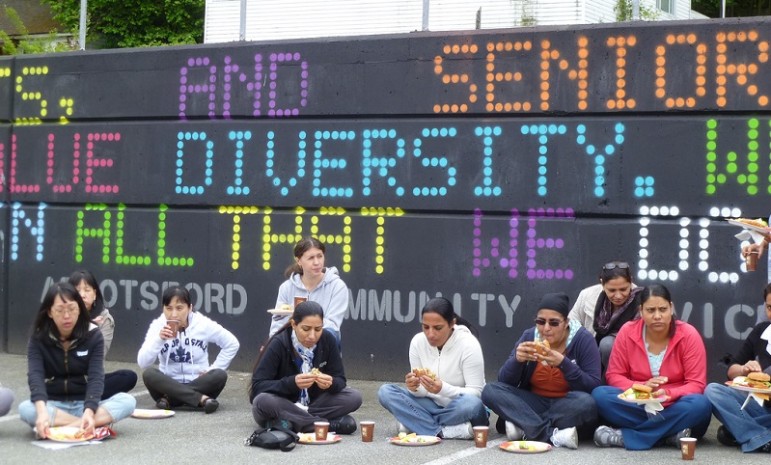
October 14, 2015; Campaign US and Syracuse New Times
Calls for increased diversity are no longer episodic or quixotic; they are regularly heard across our business and cultural landscapes. And, if trends we see currently with Millennials continue, the need to cultivate diverse arts audiences will increase. Advertising Week this year identified the need to focus on diversity as a main theme, pointing out that while Millennials represent our “largest (and most diverse) generation, most marketing decisions and campaigns are run by alarmingly non-diverse groups.” Science News reported, too, that Americans are growing more genetically diverse, “choosing mates with ethnic backgrounds different from their own.”
In the arts, the desire for change bumps up against a number of challenging realities. One is that there are fewer non-white artists and organizations in traditional areas of the arts, such as classical music, and it takes time and a commitment to arts education to effect a change. Afa Sadykhly Dworkin, president and artistic director of the nonprofit Sphinx, and her husband, Aaron Dworkin, who is a MacArthur fellow who served in the Obama administration, have been working to change that for quite some time. Sphinx, headed by Ms. Dworkin as president, operates programs that reach “over 100,000 students, as well as live and broadcast audiences of over two million annually.” Last week, for example, Syracuse, which has “the highest rate of concentrated poverty among black and Hispanic communities” in the U.S., benefited by having the Sphinx Virtuosi ensemble perform at schools throughout the city and at the Red House Arts Center at Syracuse University.
Dworkin, whose organization is based in another struggling city, Detroit, and who runs yearlong programs there, has seen the impact arts education can make, providing “a place of refuge and a place where [children] can feel confident, where they can have fun and have a break from their everyday challenges.”
As in other traditional areas of art, “classical orchestras tend to be overwhelmingly white. According to a 2012 report by the League of American Orchestras, only 4.5 percent of orchestra musicians are black or Latino—hardly representative of the general population, which, according to the 2010 census, was 13.6 percent black and 16.3 percent Hispanic or Latino.” Sphinx has been responding to that in a variety of ways, including providing free violins and lessons to elementary students in underserved communities, hosting a summer camp to work with aspiring young musicians who “demonstrate aptitude toward classical music but lack resources and access,” and by sponsoring an annual national string competition for Black and Latino youth. Red House Arts Center has worked similarly on the local level in Syracuse, to help underserved populations by “creating opportunities…and bringing the arts to students in struggling Syracuse elementary schools reaching 2,200 kids each day.”
“In the Syracuse City School District, about 10 percent of students in kindergarten through eighth grade play instruments, and about 65 percent participate in choral ensembles. In high school, students generally choose one or the other, or participate in art classes,” according to the Syracuse New Times. Sarah Gentile, supervisor of fine arts there, has been working had to improve that, but that type of change requires funding, parental and community support.
Sign up for our free newsletters
Subscribe to NPQ's newsletters to have our top stories delivered directly to your inbox.
By signing up, you agree to our privacy policy and terms of use, and to receive messages from NPQ and our partners.
A big part of the equation is the value placed on arts education and the arts by the society overall. According to Americans for the Arts, “In America, the arts are often seen as a luxury. They are the first thing to go when school boards cut budgets, and successful arts policy is seen as the exception, not the rule.” As Creatiquity, a research-backed news site that explores issues in the arts, said in an article entitled “Why Don’t They Come,”
People with lower incomes and less education participate at lower rates in a huge range of activities, including not just classical music concerts and plays, but also less ‘elitist’ forms of engagement like going to the movies, dancing socially, and even attending sporting events.
Jennifer Swan reported on this for the NPQ Newswire at the beginning of this year, outlining findings from three National Endowments for the Arts (NEA) studies. The article concluded with a quote from NEA Chairman Jane Chu:
“The implications from this research are significant. The findings show that there is great diversity in how people engage in the arts, and this gives us a framework to use our creativity to innovate new ways to reach these audiences.”
At a time when funding and support for arts and cultural nonprofits is on a decline, it is more important than ever to prove their importance to our representatives, communities, and leaders. With reports like these, and other arts advocacy groups like Americans for the Arts, we are evolving from a perspective of “art for art’s sake” into one of “art for business’s sake.” No longer are arts and culture something “extra”—they are an economic driver with an impact on our neighborhoods, our jobs, our employment, and, as always, our creativity.—Susan Raab













